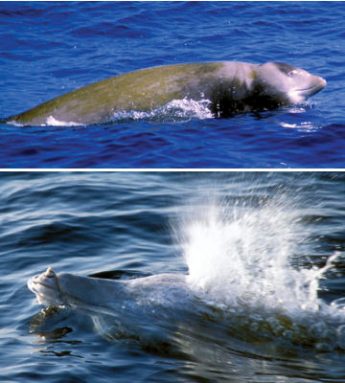Hearing whales
At least one type of whale hears by using its jaw and throat to bring sound to its ears.
Share this:
- Share via email (Opens in new window) Email
- Click to share on Facebook (Opens in new window) Facebook
- Click to share on X (Opens in new window) X
- Click to share on Pinterest (Opens in new window) Pinterest
- Click to share on Reddit (Opens in new window) Reddit
- Share to Google Classroom (Opens in new window) Google Classroom
- Click to print (Opens in new window) Print
By Emily Sohn
Ears are for hearing—everyone knows that. But for a creature called the Cuvier’s beaked whale, hearing starts in the throat, a new study finds.
The observation might help explain how all whales hear, researchers say. The work might also help scientists understand how animals are affected by underwater sonar. This radarlike technology, used by some ships, sends out sound waves to detect and locate underwater objects.
 |
|
One of 80 species of toothed whales, the Cuvier’s beaked whale, pictured here, seems to take in sounds through its throat.
|
| Dee Allen |
The Cuvier’s beaked whale is a so-called toothed whale. About 80 species belong to this group, which also includes pilot whales, dolphins, orcas, and sperm whales.
Toothed whales dive deep into the ocean in search of food. As the whales hunt, they produce sounds that bounce off objects and then return to the whales. This process, called echolocation, allows the animals to “see” the shape, size, and location of their prey, even when they’re 1,000 meters deep under the sea, where it is totally dark (see “Echoes of Hunting”).
To better understand how the whale hears, researchers from San Diego State University in California took three-dimensional X rays of two Cuvier’s beaked whales. The whales had died and washed up on the beach.
Ted Cranford and his San Diego State colleagues used the images to create a computer model of a Cuvier whale’s head. Then, they modeled the process of sound traveling through the head.
The researchers knew that some sounds get to the ears of a toothed whale through a structure called the acoustic window. Found on the lower jaw, this structure is very thin on the outside and has a large pad of fat on the inside.
When the researchers used their computer model to track how sound waves travel in the whale’s head, they were surprised to find that sounds coming from right in front of the whale actually travel under the animal’s jaw. From there, sound waves move through the throat, into a hole in the back of the jaw, and finally to the pad of fat near the animal’s ears.
Cranford suspects that other types of whales may hear through their throats. Further testing is needed to be sure. Eventually, insight into how whales hear might explain whether sonar testing by military ships is causing a spike in whale strandings—when the animals seem to get confused and wind up on beaches.







